NVIDIA GeForce GTX 760 Review: The New Enthusiast Kepler
by Ryan Smith on June 25, 2013 9:00 AM ESTPower, Temperature, & Noise
As always, last but not least is our look at power, temperature, and noise. Next to price and performance of course, these are some of the most important aspects of a GPU, due in large part to the impact of noise. All things considered, a loud card is undesirable unless there’s a sufficiently good reason – or sufficiently good performance – to ignore the noise.
With both the 600 series GK104 parts and the GK104 based GTX 770 as a backdrop here, we’re not expecting any great surprises here. Power consumption is going to approach the GTX 670 thanks to GPU Boost 2.0 and the identical TDPs. And since the cooler is also the same, acoustics should also be similar. Only idle power should show any real variation.
| GeForce GTX 760 Voltages | ||||
| GTX 770 Max Boost | GTX 760 Max Boost | GTX 770 Idle | ||
| 1.2v | 1.2v | 0.850v | ||
Like the GTX 770, GTX 760 is spec’d to a stock top voltage of 1.2v. This buys NVIDIA the 1100MHz+ clockspeeds we’re seeing, but it drives up power consumption.
| GeForce GTX 760 Average Clockspeeds | |||
| Max Boost Clock | 1149MHz | ||
| DiRT:S |
1134MHz
|
||
| Shogun 2 |
1127MHz
|
||
| Hitman |
1149MHz
|
||
| Sleeping Dogs |
1139MHz
|
||
| Crysis |
1145MHz
|
||
| Far Cry 3 |
1132MHz
|
||
| Battlefield 3 |
1123MHz
|
||
| Civilization V |
1139MHz
|
||
| Bioshock Infinite |
1131MHz
|
||
| Crysis 3 |
1105MHz
|
||
Looking at the average clockspeeds among our games, despite the official 1033MHz boost clock for GTX 760 always boosts to an average over 1100MHz, with most games boosting to around 1130MHz. The limiting factor here is typically temperatures, which quickly hit 80C at the highest boost bin and its 1.2v operating voltage. A card with a better cooler would likely have no trouble sustaining 1149MHz here.
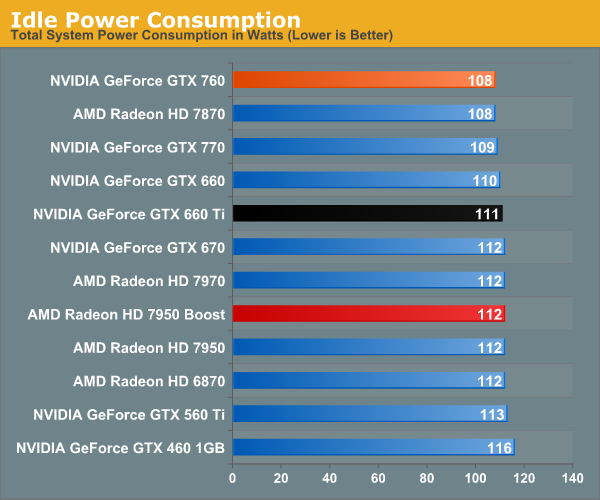
As we saw with the GTX 770 a few weeks ago, NVIDIA’s idle power consumption as measured at the wall has come down a couple of watts compared to the older GK104 cards. With a lower idle clockspeed compared to the GTX 660 Ti and its ilk, NVIDIA has been able to shave off that wattage without any more substaintial changes. However I continue to be surprised that we’re seeing any difference between the GTX 760 and the 7950B, as AMD is no slouch here either.
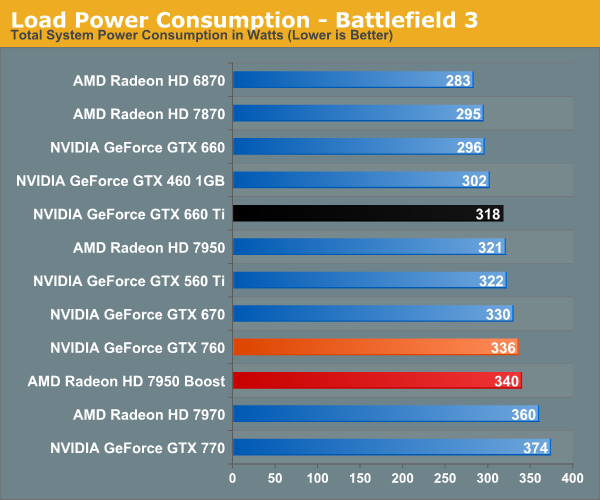
Moving on to load power under Battlefield 3, our results validate our earlier theories on power consumption based on the spec sheets. Wall power with a GTX 760 is 6W higher than GTX 670 in this test, and 18W higher than with a GTX 660 Ti. There’s no getting around the fact that GTX 670-like performance requires GTX 670-like power consumption.
At the same time the power consumption of the GTX 760 is almost identical to the 7950B at the wall. Though given the 7950B’s lower performance in this benchmark, what we’re actually seeing is lower CPU power consumption offsetting the 7950B’s higher power consumption.
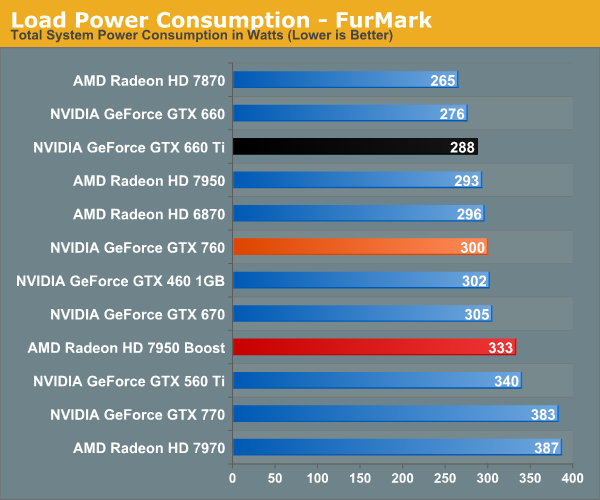
With Furmark the story is fairly similar for the NVIDIA cards, all of which come close together due to their similar TDPs. Meanwhile the 7950B pulls about 30W more at the wall, in-line with its 200W TDP. NVIDIA edged out AMD on power efficiency with the 600 series, and we’re going to see the same thing on the 700 series.
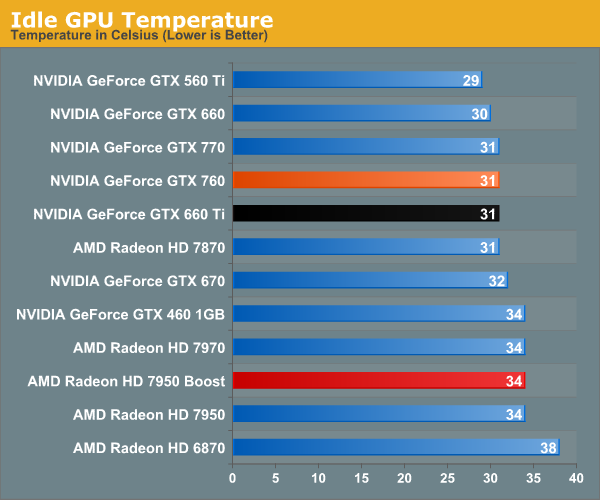
Based on the same cooler and GPU as the GTX 670, the GTX 760 offers no grand revelations here. 31C is standard for this type of blower cooler.
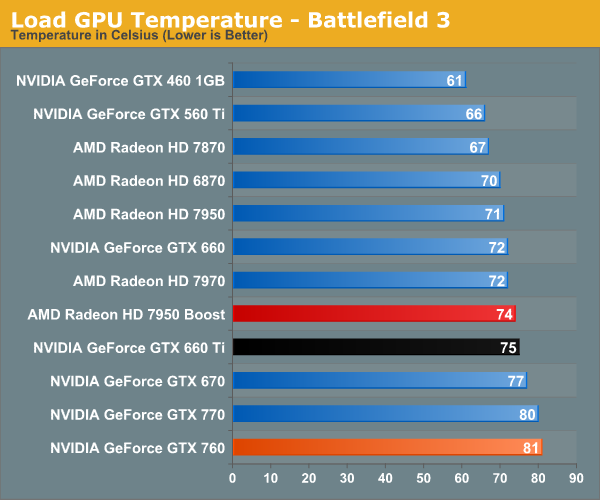
Even though the GTX 760 and GTX 670 have identical TDPs, the presence of GPU Boost 2.0 means that the GTX 760 operates nearer its TDP more often, and in this case the 80C throttle imposed by GPU Boost makes itself felt. 81C does end up being the worst among the cards in this collection, but it’s a reasonable temperature for a GK104 GPU, to the point where in temperature limited scenarios this is exactly where it’s designed to top out at.

With FurMark our results are much the same as with BF3. The slower response time of the fans on the GTX 770 and GTX 760 mean that both cards top out at 82C before temperatures level out, a few degrees warmer than with the GTX 670 and GTX 660 Ti. Alternatively the 7950B and its more powerful fan keep temperatures at or below 75C for any workload we throw at it.
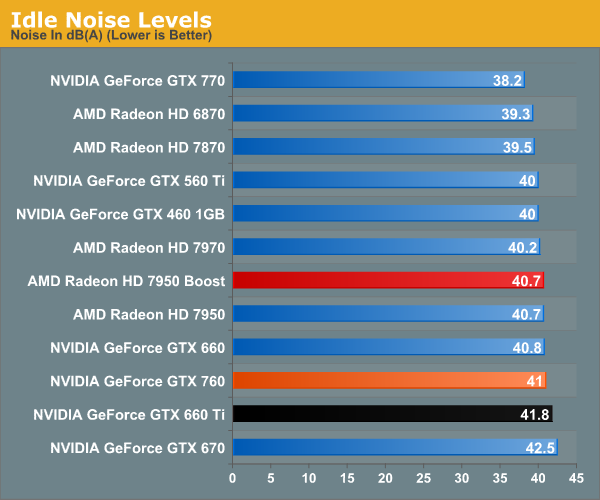
Since NVIDIA used the same cooler/fan assembly as on the GTX 670, the GTX 760 is going to give us similar acoustics. Unfortunately that includes the characteristic faint grinding noise that we’re previously mentioned. Idle noises as a result are respectable, but GTX 770 this is not.

Moving to fan noise under load, here we can see NVIDIA’s default fan curve and 80C throttle once again pay off. The GTX 760 hits 50dB under BF3, which for this specific cooler is actually doing a bit better than average, as evidenced by the slight advantage the GTX 760 has over the GTX 670. The GTX 770 and Fermi cards are something of spoilers here though, a reminder of what the Titan cooler and open air cooling can do. We will have some custom GTX 760s next week, so it will be interesting to see how much better these cards are when it comes to noise. 50dB is by no means bad, especially for the performance, but at this point we’ve seen lower noise levels out of cards with similar price tags and TDPs.
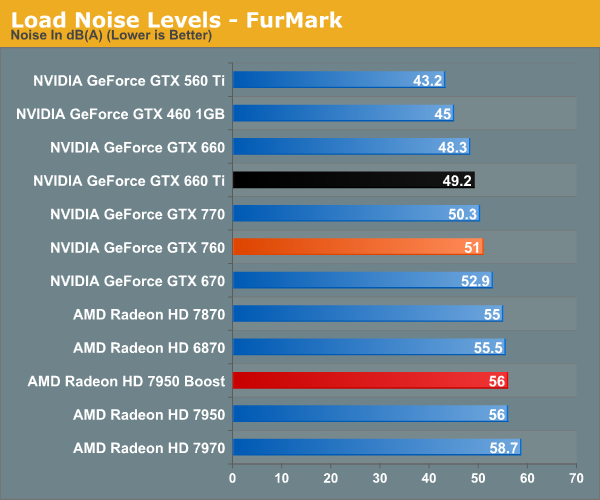
Finally, FurMark once again paints a picture very similar to what we saw with Battlefield 3. For NVIDIA cards this is middle of the road, while at 5dB quieter than the reference 7950B it’s a significant improvement.










110 Comments
View All Comments
kennyG - Tuesday, June 25, 2013 - link
I for one was not happy with the out come of the 760 tested . I wanted Nvidia to totally take the 670 and enhance it and make a 760..Do the same process like they did with the 680 to 770. I really wanted to buy this card... Waiting for this one and I'm pisssed.Laststop311 - Tuesday, June 25, 2013 - link
I wonder how 2 of these(500) in sli compared to the GTX 780 single gpu (650)xTRICKYxx - Wednesday, June 26, 2013 - link
About Titan/GTX 690 levels.Ribozyme - Tuesday, June 25, 2013 - link
Ryan, could you please elaborate why the 760 draws considerably more power than a 670 while still being slower? Is this because a lower clocked 670 is compared to a pretty high clocked 760 in comparison? What would the situation be if you compared a 760 to a 670 clock per clock? And would I be able to power this with a be quiet straight power e9 400w + 3770k folding 24/7 ?And last question, are your power consumption values measured from the socket with a watt meter or with ampere meter on each cable and then added up?
Ryan Smith - Tuesday, June 25, 2013 - link
The biggest difference between the 760 and 670 is that the 760 has GPU Boost 2.0, which is a significantly different method of adjusting clockspeeds around temperature and power limits. The 670 had a TDP of 170W, but in practice its power target (a concept that doesn't exist with Boost 2.0) was below that. Whereas the GTX 760, if not constrained by temperatures, will get closer to its 170W TDP more frequently.The other difference is as you note: clockspeeds. The GTX 760 has fewer SMXes, but it operates at a higher clockspeed and with higher voltages (1.2v vs. 1.175v). That really eats up power at the highest boost bins. The 760 is essentially a little less wide and a little deeper than 670; clock for clock the 670 is going to be faster (but it won't be able to clock quite as high).
As for your PSU question, I'm afraid I can't answer that in any confidence. Based on specs I'd think that would work, but I don't know anything about that PSU.
Finally, power consumption is measured at the wall.
JimmiG - Wednesday, June 26, 2013 - link
Many non-reference GTX 670's boost higher, though. For example, my KFA² GTX 670 almost always boosts to 1,189 MHz, sometimes higher. If you can find a cheap, non-reference GTX 670 before they go out of stock, it might be a better deal.vision33r - Tuesday, June 25, 2013 - link
The last 3 years we saw really no innovation in the desktop GPU market. If you bought a HD 5870, you can still rock that card today in every game without any issue. We will see most of today's card get tossed when 4k monitors become a reality. Even SLI/CF top end cards today will score sub 30fps when games are played natively at 4k res.Kutark - Tuesday, June 25, 2013 - link
Ive been looking for the right price point to upgrade my GTX570, especially with BS4 coming out soon. I was hoping this would be it, but it looks like its really not enough of a jump to justify $250, especially when i could put that money towards a PS4 for some of the console games that wont be ported to PC. Any opinions otherwise?Kutark - Tuesday, June 25, 2013 - link
Haha, meant to say BF4, but yah, you get what i meant lol.mapesdhs - Tuesday, June 25, 2013 - link
:D That was a good one. :)
I suppose it depends on what you want from an upgrade. Are you looking for at
least a 2X speedup? If so then yes, atm you'd probably have to aim higher than
a 760. Indeed, I have a hunch that 570 SLI might match a 770 (that's an option I
suppose, get a 2nd used 570 for the interim).
Ian.